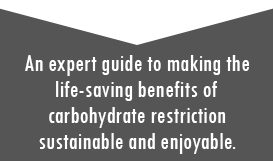The Art and Science of Low Carbohydrate Performance
 In The Art and Science of Low Carbohydrate Performance, we specifically address how a low carbohydrate diet can be used by athletes. In ‘The Art and Science of Low Carbohydrate Living’, we made a strong case for low carbohydrate diets as the preferred approach to managing insulin resistance (aka carbohydrate intolerance). However, on the continuum of insulin resistance, athletes as a group cluster on the side of insulin sensitivity. Thus most athletes do not have anywhere near the same level of carbohydrate intolerance as someone who is overweight with metabolic syndrome or diabetes.
In The Art and Science of Low Carbohydrate Performance, we specifically address how a low carbohydrate diet can be used by athletes. In ‘The Art and Science of Low Carbohydrate Living’, we made a strong case for low carbohydrate diets as the preferred approach to managing insulin resistance (aka carbohydrate intolerance). However, on the continuum of insulin resistance, athletes as a group cluster on the side of insulin sensitivity. Thus most athletes do not have anywhere near the same level of carbohydrate intolerance as someone who is overweight with metabolic syndrome or diabetes.
Why then would we recommend a low carbohydrate diet for athletes? After all, the current majority group-think in sports nutrition holds that all athletes have an obligate need for carbohydrate. But despite having the best intentions, the majority view does not always represent the truth. Besides exacerbating insulin resistance, a high carbohydrate diet also locks a person into a dependence on carbohydrate as the dominant fuel for exercise. And every endurance athlete knows what happens to performance when their carbohydrate tank (at best holding 2000 Calories) runs dry – performance goes down in flames. It’s an unfortunate reality that the human body is unable to promptly switch from carbs to fat as its predominant exercise fuel, so once the former is gone, you can’t power your performance with fat (even though a carbohydrate-depleted body still has tens of thousands of fat Calories on hand).
The key fact underlying this book is that you can train your body to burn fat by simply changing your diet over a period of a few weeks, thereby turning blood sugar and glycogen into secondary fuels. Once you make this transition, you can then train harder, perform longer, and recover faster. So the simple answer to why we endorse a low carbohydrate lifestyle for athletes is that this strategy has worked for us and many people we know. More importantly, we have both conducted and published human research that supports this approach, adding to a growing body of literature that now points to the merits of reducing dietary carbohydrates to optimize fat metabolism. We have thus accumulated a unique knowledge base that we want to share so you too may experience it for yourself.
AMAZON REVIEWS
The only book of its kind
By Karl P. Allen (South Carolina)
I highly recommend this book. I’ve read a lot about low-carb and ketogenic diets but I could never find anything that specifically talked about athletes on a ketogenic diet. I was searching and hoping to find a journal article or any study that would help me decide if keto was right for. I found this book and was more than impressed. If you are active and wondering if this book is for you, it is. I’m just a recreational athlete that likes to do CrossFit and so far this is working great.
Very simple to understand yet thorough at the same time. The authors do a great job of explaining things in layman’s terms yet still cover the scientific basis of the ketogenic diet. Just get the book and then give it to all your Paleo friends that insist the body needs carbs to function. I’ll give you a hint….your muscles do NOT need to replenish glycogen stores when they are oxidizing fat for fuel!
The final pieces of the Low-Carb jigsaw
By Stephen Ferguson (London)
This is not an completely unbiased review. Having “caught” a bad case of Type 2 diabetes a year ago I quickly discovered Dr. Bernstein’s Diabetes Solution: The Complete Guide to Achieving Normal Blood Sugars and followed his (still somewhat controversial) ketogenic diet plan, and began to devour as much information as possible on low-carb diets. Although I found inspiration from many places (including Good Calories, Bad Calories: Fats, Carbs, and the Controversial Science of Diet and Health (Vintage), and Dr Feinman’s blog), the more I read, the more I came across Phinney and Volek.
Their companion volume The Art and Science of Low Carbohydrate Living: An Expert Guide to Making the Life-Saving Benefits of Carbohydrate Restriction Sustainable and Enjoyable gave me the best possible practical guide and scientific justifcation for pursuing a low-carb lifestyle, and gave me the confidence to reduce my HbA1c from 10.2% to 4.5% (a properly non-diabetic number).
However, as a keen runner training for a half-marathon, I had still had significant concerns about attempting endurance events without resorting to carbohydrate fuelling that would disrupt my ketosis and aggravate my diabetes. Despite many hours trawling the internet I couldn’t find much quality advice on ketosis and athletic performance, and had many questions relating to “liver-dumping” and the necessity for pre- and post-exercise fuelling. This book answered every question and I devoured it in a single sitting.
After adopting their advice (as predicted) I ran two of the worst 5k races of my life, followed by rapid improvements week by week, which eventually led to me knocking almost 2 minutes off my 5k PB. I can’t wait to run my first carb-free half marathon later this year.
It’s too easy to say that a book changed your life, but in this case both the “Art and Science Books” have fundamentally impacted my health and my athletic performance.


 NEWLINEINFO CORP
NEWLINEINFO CORP